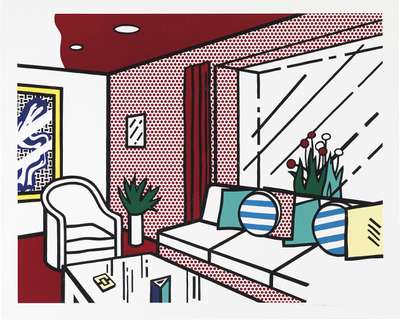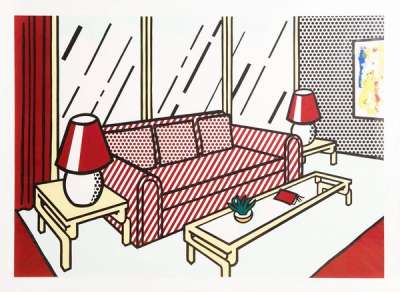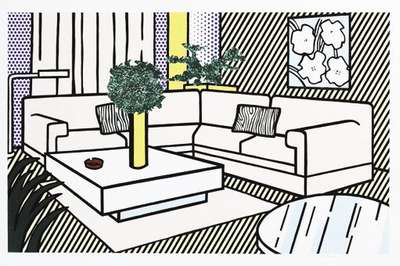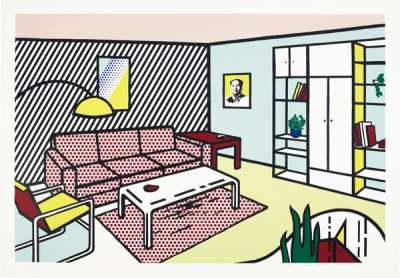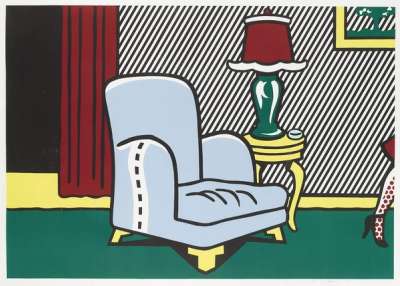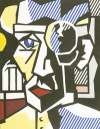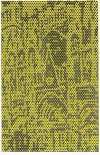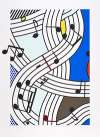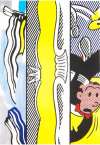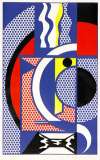Interior
Referencing everyday furniture advertisements and Roy Lichtenstein's own photographs, the Interior series was created at the beginning of the 1990s, towards the end of the artist’s career. Inspired by modern home décor, each vision of quotidian domesticity is rendered in characteristically bold primary colours, delineated outlines, and Ben Day dots.
Roy Lichtenstein Interior For sale
Interior Value (5 Years)
Works from the Interior series by Roy Lichtenstein have a strong market value presence, with 90 auction appearances. Top performing works have achieved standout auction results, with peak hammer prices of £121943. Over the past 12 months, average values across the series have ranged from £12146 to £104472. The series shows an average annual growth rate of 6.03%.
Interior Market value
Auction Results
| Artwork | Auction Date | Auction House | Return to Seller | Hammer Price | Buyer Paid |
|---|---|---|---|---|---|
 Wallpaper With Blue Floor Interior Roy Lichtenstein Signed Print | 25 Nov 2025 | Bonhams New York | £10,200 | £12,000 | £16,000 |
 Modern Room Roy Lichtenstein Signed Print | 22 Oct 2025 | Sotheby's New York | £59,500 | £70,000 | £90,000 |
 Bedroom Roy Lichtenstein Signed Print | 26 Sept 2025 | Sotheby's New York | £51,000 | £60,000 | £80,000 |
 Living Room Roy Lichtenstein Signed Mixed Media | 26 Sept 2025 | Sotheby's New York | £85,000 | £100,000 | £130,000 |
 The Den Roy Lichtenstein Signed Print | 26 Sept 2025 | Sotheby's New York | £51,000 | £60,000 | £80,000 |
 Red Lamps Roy Lichtenstein Signed Print | 26 Nov 2024 | Bonhams New York | £59,500 | £70,000 | £90,000 |
 Yellow Vase Roy Lichtenstein Signed Print | 16 Apr 2024 | Christie's New York | £42,500 | £50,000 | £70,000 |
 La Sortie Roy Lichtenstein Signed Print | 18 Oct 2016 | Doyle Auctioneers & Appraisers | £34,000 | £40,000 | £50,000 |
Sell Your Art
with Us
with Us
Join Our Network of Collectors. Buy, Sell and Track Demand
Meaning & Analysis
Inspired by everyday furniture advertisements and Lichtenstein's own photographs, the Interiors series is the artist at his most recognisable. Born in Manhattan in 1923, Lichtenstein’s distinctive artistic style was inspired by the pervasive visual language of consumerism and American popular culture. Offering a culturally relevant aesthetic, Lichtenstein frequently evoked images, letterings, and figures that were appropriated from comic strips. He borrowed artistic techniques from the commercial printing industry in his work, utilising methods like lithography, woodcut, and screen printing.
Lichtenstein’s Interior series was created at the beginning of the 1990s and towards the end of the artist’s career. The printed sequence was inspired by clippings and images collected from everyday furniture advertisements by the artist himself. Cribbed from visuals of quotidian domesticity, these interiors are rendered in characteristically bold primary colours, delineated outlines, and Ben Day dots.
Whilst Lichtenstein's work derives from the visual vocabulary of popular culture, cartoon-like and mass-produced, his approach was in fact highly sophisticated and meaningful. His work was not only a satirical mirror to the society in which he worked but also remains decidedly relevant today. The messages, oftentimes concealed and on other occasions blatantly obvious, speak of universal themes ranging from human emotion to gender politics.
Throughout the rest of his prolific career, Lichtenstein continued to build up a rich œuvre consisting of over 5,000 works that experimented with a variety of different media. These included paintings, prints, and even three-dimensional sculptures in painted bronze and ceramic. His artworks are to this day exhibited in over 200 solo exhibitions in galleries around the world and his collections are housed in many prestigious institutions across the globe. Lichtenstein’s timeless work has sustained a consistent level of popularity both during and after his lifetime, making it accessible to a range of audiences. With this in mind, the Interior series forms a distinctive and accomplished contribution to Lichtenstein’s profitable career.

